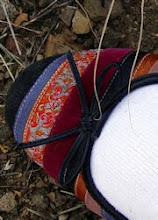These trees are fairly common here in Prescott. They take an incredibly long time to grow because they live in such an arid landscape. When I walk in their shade, down nearby hiking trails, I take note that some are hundreds of years old.
This is a nice specimen with a full canopy. I took this photo on Prescott trail 62, near The Ranch at Prescott. This tree could be a couple of hundred years old. Not many of the trees that I've seen are this symmetrical or this full.
I'm not sure why some of the alligator juniper branches die and break off, but this seems to be pretty common also - at least around here. I took this photo on Prescott trail 301 (near the Lynx Creek Pueblo ruins). It was sheltering a nearby, hollowed out alligator juniper tree tunk (below).
Alligator junipers have a very distinctive bark with a scaley appearance (thus the name). The scale colors range from gray to brown.
As the trees form branches, the scales grow around them. When the branches die and fall, they leave a distinct "hole" around what is left of the dead branch.
While the trunks have a scaley pattern, the branches have the look of shaved chocolate - brown and peeling away (yum).
On Prescott trail 62 in January, I came upon an alligator juniper that had dropped most of its berries. This is a close up of just a few of the thousands of berries that blended with the carpet of juniper needles.







4 comments:
Neat series of photos... all you're missing is that dusting of yellow over everything during juniper allergy season!
thanks for this bit on alligator junipers - I'm new here and was wondering what type of tree they were Nice photos!
These pictures are going to help teach some Webelos - Cub Scouts about Forests for their Forester Activity Badge!
The alligator juniper is one of my favorite in the Juniper family.
Here's a few more facts about them:
This evergreen is the largest juniper species in Arizona and reach 50 ft high with a trunk up to 4 ft thick.
The bark on older trees are separated into fissures that create 1-2 inch squares that look like an alligator's hide.
The hard, 4 seeded cones are reddish brown underneath a waxy coating and are about 1/2 inch wide. They take two years to mature and are eaten by wildlife.
The dense, scalelike & pointed needles are blueish green and are about 1/16th inch long.
It occurs in oak and pinyon-juniper woodlands also lower elevation ponderosa pine areas in the range of 4500 to 8000 ft elevation.
The crown of this slow growing tree is pyramidal or rounded. They have a life expectancy of about 500 to 800 years with records of 1100 and 1400 years old.
It is native to AZ, NM & TX in the USA.
Post a Comment